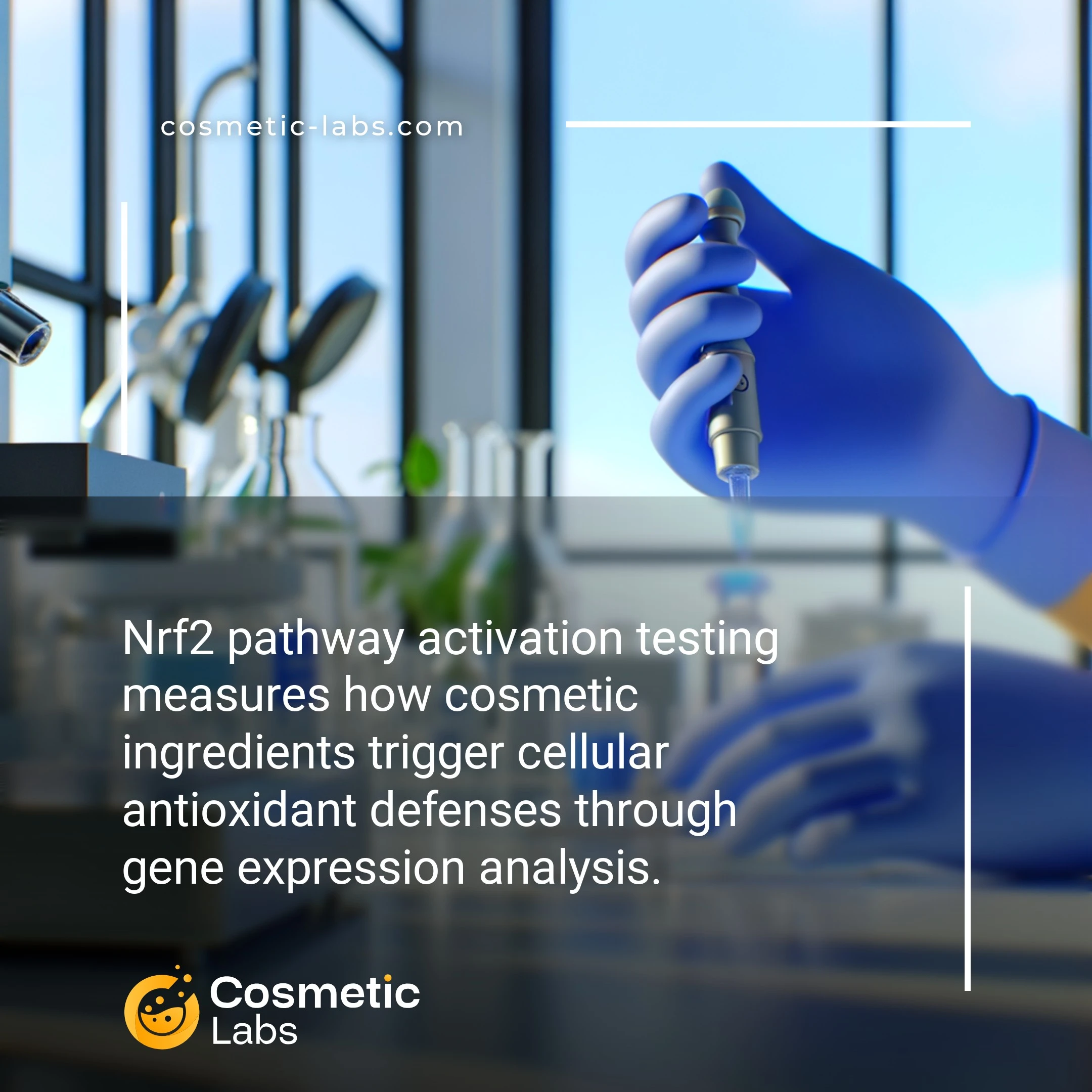Nrf2 Pathway Testing Services for Antioxidant Efficacy

What is Nrf2 pathway activation?
Nrf2 pathway activation testing is a cellular defense mechanism assessment that measures how well cosmetic ingredients trigger antioxidant enzyme production in skin cells. Our partner labs use specialized cell culture assays to evaluate whether your formulations can activate the Nrf2 transcription factor, which controls over 200 protective genes including glutathione peroxidase and superoxide dismutase. This testing reveals your product’s ability to boost natural cellular defenses against environmental stressors like UV radiation and pollution.
Why do you need this service?
Cosmetic labs use Nrf2 pathway activation testing to validate anti-aging serums and protective skincare formulations before market launch. Teams measure cellular defense responses in skin models exposed to UV radiation, pollution particles, and blue light stressors to demonstrate product efficacy. This testing provides quantifiable proof of antioxidant protection that supports marketing claims and regulatory submissions for premium skincare lines targeting environmental damage prevention.
Who provides Nrf2 pathway activation services?
All cosmetic labs providing Nrf2 pathway activation services
There is no company providing these services at the moment.
Nrf2 Pathway Activation Testing for Antioxidant Efficacy
Nrf2 pathway activation testing measures how effectively your cosmetic ingredients trigger cellular antioxidant defenses. This molecular pathway controls the production of protective enzymes that neutralize free radicals and reduce oxidative damage in skin cells.
Cellular Response Measurement
Labs use cell culture models to track Nrf2 nuclear translocation and downstream gene expression. When activated, this transcription factor moves from the cytoplasm to the nucleus, where it switches on antioxidant enzyme production. Testing protocols measure this movement using fluorescent imaging and qPCR analysis.
Key markers include:
- Heme oxygenase-1 (HO-1) expression levels
- NAD(P)H quinone oxidoreductase activity
- Glutathione S-transferase upregulation
- Catalase and superoxide dismutase production
Dose-Response Validation
Testing services establish the minimum effective concentration for Nrf2 activation in your formulations. Labs run concentration curves from 0.1% to 5% ingredient levels, measuring both pathway activation and cell viability. This data helps optimize ingredient ratios for maximum antioxidant benefit without cytotoxicity.
Results include EC50 values for pathway activation and safety margins for formulation guidance. Many labs also test ingredient combinations to identify synergistic effects that enhance cellular antioxidant capacity.
Connect with specialized testing labs on our platform to validate your antioxidant claims through Nrf2 pathway analysis and comprehensive oxidative stress evaluation.
Practical Applications of Nrf2 Pathway Activation Testing
Beauty brands use Nrf2 pathway activation testing to validate antioxidant claims and optimize formulations for protective skincare products.
Anti-Aging Product Development
Labs measure Nrf2 activation levels to assess how well ingredients protect against environmental stressors. This testing helps brands validate claims about pollution protection, UV defense, and cellular repair mechanisms. Quantitative results from Nrf2 assays provide concrete data for marketing materials and regulatory submissions.
Testing protocols typically evaluate ingredient concentrations between 0.1-10% to determine optimal dosing. Labs use reporter gene systems and western blot analysis to measure pathway activation within 24-72 hours of treatment.
Ingredient Screening and Optimization
Cosmetic labs screen botanical extracts, peptides, and synthetic compounds for their ability to trigger cellular defense responses. This screening identifies promising ingredients before expensive stability and safety testing begins. Teams compare multiple candidates using standardized Nrf2 activation assays to rank effectiveness.
The process involves dose-response curves, time-course studies, and mechanism validation. Labs typically test 5-10 concentrations per ingredient to establish optimal activity ranges for formulation development.
| Testing Method | Timeline | Key Metrics | Best For |
|---|---|---|---|
| Luciferase Reporter Assay | 24-48 hours | Fold activation, EC50 | High-throughput screening |
| Western Blot Analysis | 2-7 days | Protein expression levels | Mechanism validation |
| qPCR Gene Expression | 1-3 days | mRNA fold change | Pathway confirmation |
| Immunofluorescence | 3-5 days | Nuclear translocation | Visual pathway tracking |
Ready to validate your antioxidant formulations? Connect with specialized labs on our platform to access Nrf2 pathway testing services tailored to your product development needs.
